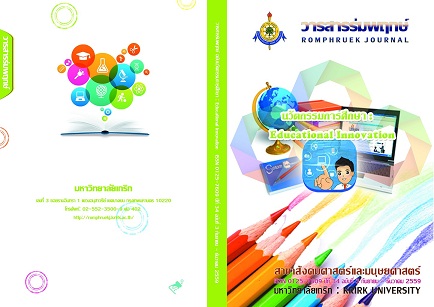การสร้างการรับรู้ของสถานีโทรทัศน์ดิจิทัลให้เป็นที่จดจำของผู้ชม;Perception Creation of Digital Television Station to Be Remembered by Viewers
Main Article Content
Abstract
การสร้างการรับรู้เป็นวิธีการสำคัญของธุรกิจโทรทัศน์ดิจิทัล ที่จะช่วยให้ผู้ชมเกิดพฤติกรรมการเปิดรับชมรายการโทรทัศน์สถานีใดสถานีหนึ่ง และหากผู้ชมเกิดการรับรู้อย่างต่อเนื่องจนเกิดเป็นการจดจำหรือทำให้ผู้ชมนึกถึงเป็นลำดับต้นๆ ก่อนการตัดสินใจเลือกรับชมรายการใดรายหนึ่ง ก็มีแนวโน้มที่จะทำให้ผู้ชมเลือกรับชมรายการที่ตนจดจำได้ก่อนเป็นลำดับแรก ดังนั้น ผู้ประกอบการธุรกิจโทรทัศน์ดิจิทัลจึงต้องวางแผนการสื่อสารด้วยวิธีการต่างๆ เพื่อสร้างการรับรู้ให้สถานีโทรทัศน์ดิจิทัลของตนได้เป็นที่รู้จักและจดจำให้กับกลุ่มผู้ชมเป้าหมาย โดยวิธีการสร้างการรับรู้นั้นประกอบไปด้วย 5 วิธีการสำคัญ ได้แก่ การสร้างสรรค์เนื้อหารายการที่แตกต่าง การสร้างตราสินค้าของสถานีโทรทัศน์ การวางแผนการสื่อสาร การส่งเสริมและสนับสนุนให้เกิดการมีส่วนร่วม และการนำเสนอด้วยเทคนิคพิเศษ
Perceptional creation is an important method of digital television that will induce viewers to watch the program of certain television station. If viewers can continue watching successively, the program of such station can be recognized and chosen in prior to others. In fact, viewers are more likely to view the programs that they can remember first. Therefore, digital television business operators must plan the communication by various methods in order to make their digital television station to be known and remembered to targeted viewers. The perception principles consist of 5 important methods including creating different program content, creating brand of television station, communication planning, promoting and supporting participation and presentation with special techniques.
Article Details
Every article published in the Romphruek Journal of the Humanities and Social Sciences is the opinion and point of view of the authors. Thery're not the viewpoint of Krirk University or the editored department. Any part or all of the articles for pablication must be clearly cited.
References
กรุงเทพธุรกิจ. (2558). เวิร์คพอยท์ชูเกมโชว์-วาไรตี้ ย้ำผู้นำเรทติ้ง-ปรับค่าโฆษณา. กรุงเทพธุรกิจ, (32)
ขนิษฐา อมรเมศวรินทร์. (2557). พฤติกรรมการรับชม ความพึงพอใจ และการใช้ประโยชน์ของผู้ชมที่มีต่อข่าวภาคค่ำ สำนักข่าวไทย ทางสถานีโทรทัศน์โมเดิร์นไนน์. คณะนิเทศศาสตร์ มหาวิทยาลัยศรีปทุม, กรุงเทพฯ.
จอห์นนพดล วศินสุนทร. (2558). สถานการณ์การเปลี่ยนผ่านระบบทีวีดิจิทัลกับพฤติกรรมการเปิดรับสื่อ และความพึงพอใจของประชาชนในเขตอำเภอเมืองของพื้นที่ 4 จังหวัดนำร่อง. รายงานวิจัย มหาวิทยาลัยราชภัฎเชียงใหม่, เชียงใหม่.
เจิมศักดิ์ ปิ่นทอง. ทีวีดิจิทัล สัญญาต้องเป็นสัญญา. (15 กุมภาพันธ์ 2559) สืบค้นจาก http://www.naewna.com/politic/ columnist/22851.
จุฬารัตน์ ม่วงแก้ว. (2559). อัตลักษณ์รายการข่าวของสถานีโทรทัศน์สีกองทัพบกช่อง 7. การประชุมวิชาการงานวิจัยและงานสร้างสรรค์ทางนิเทศศาสตร์ ครั้งที่ 6 มหาวิทยาลัยสยาม กรุงเทพฯ, 74-82.
ไทยรัฐออนไลน์. Immersive : ย้อนรำลึกวินาศกรรม 911. (22 กันยายน 2559) สืบค้นจาก http://www.thairath.co.th/clip /4778.
ปรียนันท์ พละศักดิ์. (2556). ปัจจัยความสำเร็จขององค์กรที่ส่งผลให้สถานีโทรทัศน์ไทยรัฐทีวีเป็นที่รับรู้และ
จดจำของผู้ชมในเขตกรุงเทพมหานคร. คณะบริหารธุรกิจ มหาวิทยาลัยกรุงเทพ, กรุงเทพฯ.
ฝ่ายวิจัย ประเมินผลและพัฒนา. (2557). ฉีกกฎเก่า เล่ากฎใหม่ สร้างเนื้อหาโดนใจในยุคดิจิทัล. สื่อโทรทัศน์ในยุคดิจิทัล, 105-107.
รัตติยา อังกุลานนท์. ผู้นำทีวีดิจิทัลโหมลงทุน ชิงงบโฆษณา 8 หมื่นล้าน. (4 กรกฎาคม 2559) สืบค้นจาก
http://www.bangkok biznews.com/blog/detail/636692.
ศิริวรรณ เสรีรัตน์ ศุภร เสรีรัตน์ ปณิศา มีจินดา อรทัย เลิศวรรณวิทย์ ปริญ ลักษิตานนท์ องอาจ ปทะวานิช และ จิระวัฒน์ อนุชชานนท์. (2552). การบริหารการตลาดยุคใหม่. กรุงเทพฯ : Diamond In
Business World.
ศุภศิลป์ กุลจิตต์เจือวงศ์. (2559). นวัตกรรมกระบวนการผลิตและรูปแบบรายการโทรทัศน์ด้านสิ่งแวดล้อมศึกษา สำหรับนักเรียนระดับชั้นประถมศึกษา. การประชุมวิชาการระดับชาติในวันคล้ายวันสถาปนา
ครบรอบ 50 ปี สถาบันบัณฑิตพัฒนบริหารศาสตร์ ประจำปี 2559 วันที่ 31 มีนาคม 2559 กรุงเทพฯ.
สมชาย สกุลอือ. วิบากกรรมทีวีดิจิทัล. (15 กุมภาพันธ์ 2559) สืบค้นจาก
http://www.thansettakij.com/2016/02/10/30697.
สกุลศรี ศรีสารคราม. (2557). Transmedia Story Telling. สื่อโทรทัศน์ในยุคดิจิทัล, 159-163. สถานีโทรทัศน์พีพีทีวี. สถานีโทรทัศน์พีพีทีวี. (4 กรกฎาคม 2559) สืบค้นจาก http://www.pptvthailand.com/.
สถานีโทรทัศน์วอยซ์ทีวี. สถานีโทรทัศน์วอยซ์ทีวี. (4 กรกฎาคม 2559) สืบค้นจาก
อภิญญา ชาหารเวียง และคณะ. ความคิดเห็นของประชาชนในจังหวัดอุดรธานีที่มีต่อช่อง 3 อนาล็อก (จอดำ). (4 กรกฎาคม 2559) สืบค้นจาก http://researchudru.blogspot.com/2014/12/3-2557.html.
อาดัม, มอร์แกน. (2545). ปลาเล็กกินปลาใหญ่ : กลยุทธ์พลิกเกมการตลาดเพื่อต่อกรกับแบรนด์ผู้นำ. กรุงเทพฯ : สำนักพิมพ์ดีเอ็มจี.
Aker, D.A. (1991). Managing brand equity: Capitalizing on the value of a brandname. New York : Free Press.
Batra,R., Myer,J. G., & Aaker. D.A. (1996). Advertising management. Upper Saddle River, NJ : Prentice Hall.
Becker,S. L. (1978). Discovering Mass Communication. Illinois : Scott Foresman and Company.
Belk, R.W. (1988). Possessions and extended self. Journal of Consumer Behavior, 15(2), 139-168.
Burke, B. (1994). Positioning, personality, not price, should frame consumer message. Brandweek, 35, 36-65.
David Aaker. (1996). Building strong brands. New York : The Free Press.
Kotler,P., & Keller, K. L. (2009). A framework for marketing management. Upper Saddle River, NJ : Pearson/Prentice-Hall.
Lee, B. and Lee, R. (1995). How and why people watch TV : Implications for the future of interactive television. Journal of Advertising Research, 35(6), 9-18.
Maehle,N., & Shneor,R. (2010). On congruence between brand human personalities. Journal of product & Brand Management, 19(1), 44-53.
Ramaseshan,B., & Tsao,H-Y. (2007). Moderating effects of the brand concept on the relationship between brand personality and perceived quality. Brand Management, 14(6), 458-466.
Siguaw, J.A., Mattila, A., & Austin, J.R. (1999). The brand-personality scale : An application for restaurants. Cornell Hotel and Restaurant Administration Quarterly, 40(3), 48-55.
Smiciklas, M. Infographics and the Science of Visual Communication. (March 20, 2014)
Retrieved from http://www.socialmediaexplorer.com/digital-marketing/infographics- and-thescience-of-visual-communication/.
Smiciklas,M. (2012b). The Power of Infographics : Using Pictures to Communicate and Connect with Your Audience. Indiana : Que Publishing.
V. Vroom and P. Yetton. (1973). Leadership and decision making. Pennsylvania : University of Pittsburgh Press.
Wang, Q., Fink, E. L., & Cai, D.A. (2008). Loneliness, gender, and parasocial interaction : A usesand gratifications approach. Communication Quarterly, 56, 87-109.


